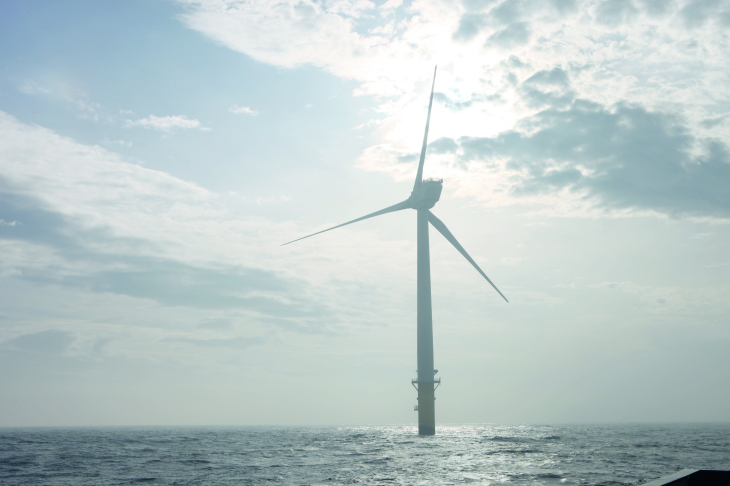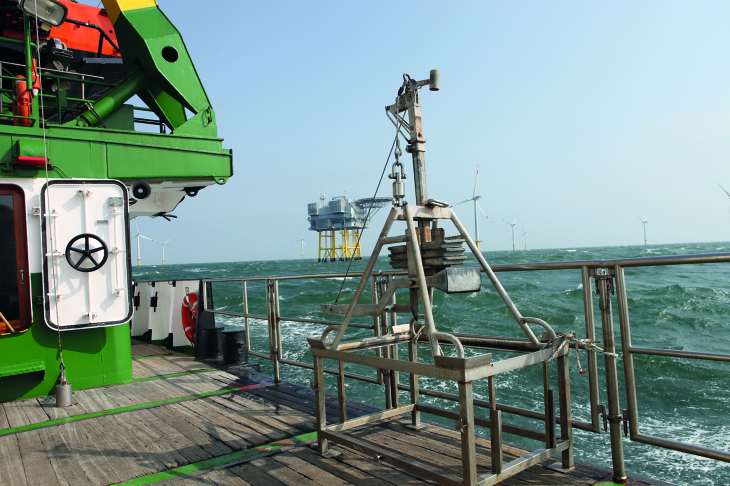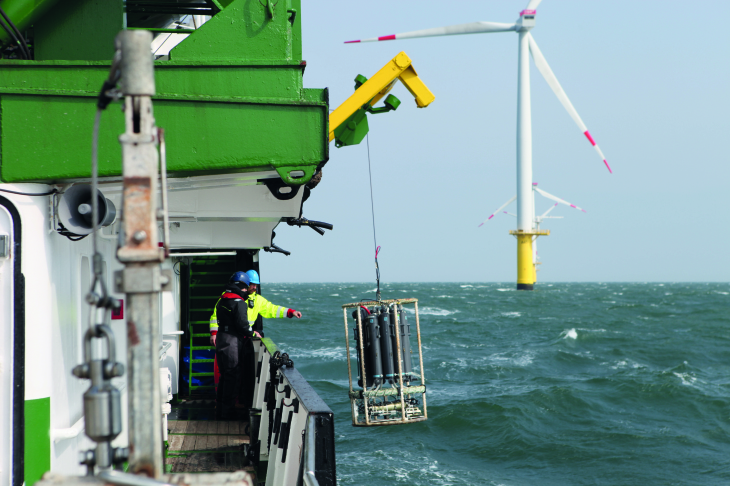Test the storm
Wind farms in the North Sea should lie at the centre of the energy revolution. How this may be accomplished is the focus of the coastal researchers at the Hereon.

Photo: Hereon/ A. Reese
Autumn came to Germany with Elmar: the storm's low pressure system ended up dropping yearly temperatures ten degrees below average, rain came down hard on the land and stormy gusts roared on the North Sea. Not a good day for excursions. But a perfect day for maximum performance: because on this 22nd of October, the Elmar storm front allowed wind farms in the German Bight to produce 4,350 megawatt hours in just one day, the highest output for 2017. This represents as much power as can be produced on land by four to five very large coal-fired or nuclear power plants.
Over the past year German wind farms delivered a total of 18 terawatt hours of power from the open sea – that is more than the city of Berlin consumes in a year. Offshore wind power plants show more and more clearly what they can provide: The first German wind farm is only eight years old and today more than 1,000 wind turbines are turning in the North Sea. According to federal government plans, the capacity of offshore parks is to be increased to 6.5 gigawatt by the year 2020.
Scientists at the Helmholtz-Zentrum Hereon have been working on the subject for a number of years now to reach this target.
- Where, for example, can we expect constant strong winds and where should such facilities be built?
- How do the huge turbine rotors affect local airflows?
- And what environmental risks can we expect from above and under water structures?
Experts from various fields are collaborating on these questions to build the main research focus “offshore wind farms” at the Institute of Coastal Research. Many surprising results have already been found: for example, environmental scientists could prove that the North Sea is noticeably less turbid around wind power plants because mussels attach to turbine pillars and filter the sea water. Oceanographers have developed a wind forecasting system which relies on marine radar images and allows extremely quick predictions (30 to 60 seconds). In the future, this will be very useful to offshore park operators to manage facilities. Social scientists also investigated how the pylons could gain more acceptance on land, where they are often perceived as visually unpleasant - their studies even involved acceptance among such diverse groups as surfers, fishermen and staff at local tourism offices.
Many research projects focusing on offshore windfarms are completely independent but take inspiration from each other. Today, their colleagues‘ current analyses are used to determine, for example, where environmental technologists take their water samples.
Three experts at the Helmholtz-Zentrums Hereon present their perspectives on the power stations of the high seas for in2science. They discuss about their sense of achievement and setbacks in the research towards the energy revolution.
Dr Beate Geyer: "Our data provide the ideal timeframe for construction of the facilities"

Photo: Hereon/ C. Schmid
It takes many months for the super computer to create our simulations. After all, it includes the climate data of the past 70 years. Once they are calculated, simulations provide definite data that is crucial for the building of wind farms. For example: which locations provide enough wind, but not too much and not too often? How strong are the waves in the worst-case scenario? When are there reliably calm phases, for example, for maintenance?
Answers to these questions are provided by the data set coastDat, which enables precise wind, temperature and sea condition analyses of a twelve-kilometre North Sea grid. That way, we can estimate the climate conditions for locations for which we do not have original measurement data.
This information is extremely important for the operators of offshore facilities. Our data does not quite determine the location of the wind farms, but rather the extent of the calm construction window because the constructors need calm seas to build. The facilities are huge, some of the rotors have a diameter of 170 meters. Loading in the harbour or building at open sea is much too dangerous during strong waves. This is why coastDat predicts the ideal time corridors within a year, which have previously coincided with preferably low wave heights. This is not only about the crew’s safety, as long waiting periods of the usually chartered transport ships in the harbour are also very expensive. Nearly all wind farm operators in the German North Sea therefore use our data for the building and planning of their facilities.

Tidal current and water level: The coastDat data set is based on numerical models. The portal has been providing scientific data for more than 15 years. It is used, for example, in the planning of offshore wind farms. ©DKRZ/Hereon
Today, nearly every other coastDat user is in industry, and yet the data set was originally developed for climate research. Such regional simulation results are much more exact than the usual global climate data. This is not only important for scientists, authorities, and offshore facility operators. For example, our data also helps with ship construction. With it, the shipyards can more precisely estimate which stresses a hull will have to endure.
And the development also continues for wind farms. Our data can determine when wind turbines on the high seas and on land collect a certain amount of energy and what energy solar panels collect during the same time period. This way, the electricity grid’s supply on land can better be planned.
Dr Jeffrey Carpenter: "The sea also has its seasons"

Photo: Hereon/ J. Lippels
I have always been interested in water; this might be because I grew up in Canada, in an area full of lakes. I have also loved maths since my studies. In my area of expertise, fluid mechanics, I can connect these two passions. I am going out to sea for my projects, especially to collect data using robots. The robot glider's probes register the water's movements and measure its density and temperature completely automatically.
Back on land, I use that data to perform various simulations which document – and predict – the water’s flow behaviour. This is important if we want to gauge how sea water will react, for example, to the wind power plant’s foundation structures. Mechanically, they create barriers, around which the currents must flow.
I am especially interested in the water's stratification: almost all lakes and seas form certain layers, which differ in temperature and density, some of them very strongly. In summer, the sun heats up the North Sea surface layer while the bottom waters remain cool. However, in winter, cooling and storms produce heavier waters that will mix with the cooler bottom waters left over from summer.
So, the sea also has its seasons. And its seasonal layering is extremely important for the animals living there because it enables them to, for example, deliberately seek zones with especially large amounts of nutrients, light, or oxygen.

The image shows a single moment of a large eddy simulation (LES). The view is from above at
the water surface; the momentary movement is from left to right. Blue indicates a strong current
and red a weak current. Photo: Hereon/J. Carpenter
Furthermore, there is usually a dividing zone between the layers called the thermocline. It is relatively quiet and stable, by contrast, at the sea surface, there is often turbulence due to winds and at the bottom due to friction. The thermocline is like a buffer between these turbulent zones. This finely balanced system could be disrupted close to wind power plants, because their foundation structures cause the normally quiet intermediate zones to whirl up and mix.
For the past four years, I have been researching what effect turbulence has. Positive effects are conceivable, say, because nutrients from the lower levels are lifted and fish will find more to eat in the higher zones. But we must also be aware of the negative consequences because our research shows that the layers react sensitively; one storm is enough to mix the North Sea down to the seabed.
Wind farms do not transfer this enormous force and yet, in the future, the presence of wind farms could be vast. With many more structures built in the sea, effects relating to the water column could have much larger consequences.
Dr Daniel Pröfrock: "Good ideas can also be harmful"

Photo: Hereon/ C. Schmid
I like working in the field out at sea. I enjoy these moments away from the desk and the laboratory, even though our journeys and campaigns are often exhausting. Most recently, we went out to the North Sea in mid-April, to sample water and sediments near offshore wind farms. Together with my team and in cooperation with our partners at the Federal Maritime and Hydrographic Agency BSH, we are investigating how the corrosion protection systems of the wind farms releases chemicals and if these have a negative impact on the marine environment – a topic on which there is currently barely any available information.
Wind turbines are usually protected from sea water, above and under water, in two ways: their surfaces are protected with coatings consisting of a wild cocktail of chemicals, including many substances that could be harmful for the environment while their foundations are equipped with so-called galvanic anodes. Multiple tons of anode materials, which mostly consist of an aluminium alloy, protect the actual structure from corrosion. This maintains the stability of the structure over the entire projected lifetime. Effectively, the anode sacrifices itself, but therein it releases problematic alloying elements, for example highly toxic cadmium and lead.

Sediment is lifted from the seabed with a box grabber. Photo: Hereon/ A. Reese
Ships also use such anodes. But it is completely unclear what the consequence to the surrounding marine environment might be when such protective systems are applied to a much larger extent in North Sea wind farms. Therefore, we examine the sea water and the sea floor around the foundations. We want to know which pollution and risks to expect around the pillars in the long term.
We will take the Hereon research ship Ludwig Prandtl out there again this year to deploy and to recover so-called passive sampling devices. These will have been deployed for one to two months at multiple locations on the wind farm and will provide data about the water’s average chemical composition during the deployment period. We also want to collect mussels, which will be deployed in parallel with the passive sampling devices using a specific cage system. This system was developed at our institute to test for possible accumulation of certain harmful substances in their tissues.
Our findings will help our project partners to develop suitable guidelines for the wind farm operator or the future approval process of new offshore parks:
- Which coating system should be permitted for use?
- Where and how often should the water quality be tested?
- How dangerous are the current galvanic protection approaches?

The water sampler is lowered into the water. It automatically collects seawater at different depths.
Back on land, the samples are examined in the laboratories in Geesthacht. Photo: Hereon/ A. Reese
After all, there are alternatives: the wind turbine foundations could be protected by so-called impressed current corrosion protection systems. In this case, facilities are slightly charged with an electrical current, which interrupts the corrosion processes. Such systems are used to protect pipelines and bridges and some wind farms also use this approach. This method has proved reliable, but it is expensive.
If we want to ensure that offshore facilities actually provide clean power in the future, we must make sure that wind farms do not create other environmental problems. After all, good ideas can also be harmful.
Author: Jenny Niederstadt
Published in in2science #6 (June 2018)
